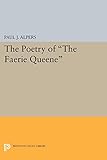Poetry of the Faerie Queene / Paul J. Alpers.
Material type: TextSeries: Princeton Legacy Library ; 1935Publisher: Princeton, NJ : Princeton University Press, [2015]Copyright date: ©1967Description: 1 online resource (426 p.)Content type:
TextSeries: Princeton Legacy Library ; 1935Publisher: Princeton, NJ : Princeton University Press, [2015]Copyright date: ©1967Description: 1 online resource (426 p.)Content type: - 9780691622866
- 9781400879854
- 821/.3 22
- PR2358 .A87eb
- online - DeGruyter
- Issued also in print.
| Item type | Current library | Call number | URL | Status | Notes | Barcode | |
|---|---|---|---|---|---|---|---|
 eBook
eBook
|
Biblioteca "Angelicum" Pont. Univ. S.Tommaso d'Aquino Nuvola online | online - DeGruyter (Browse shelf(Opens below)) | Online access | Not for loan (Accesso limitato) | Accesso per gli utenti autorizzati / Access for authorized users | (dgr)9781400879854 |
Frontmatter -- Preface -- Contents -- Part I -- Chapter One: The Rhetorical Mode of Spenser's Narrative -- Chapter Two: Narrative Materials and Stanzas of Poetry -- Chapter Three: Spenser's Poetic Language -- Chapter Four: The Problem of Structure in The Faerie Queene -- Part II -- Chapter Five: Interpretation and the Sixteenth-Century Reader -- Chapter Six: Spenser's Use of Ariosto -- Chapter Seven: Iconography in The Faerie Queene -- Chapter Eight: Interpreting the Cave of Mammon -- Part III -- Chapter Nine: The Nature of Spenser's Allegory -- Chapter Ten: Heroism and Human Strength in Book I -- Chapter Eleven: Heroic and Pastoral in Book III -- Index to The Faerie Queene -- General Index
restricted access online access with authorization star
http://purl.org/coar/access_right/c_16ec
Professor Alpers argues that Spenser's purpose in The Faerie Queene was not to create a fictional world or to imitate action, but to create and manipulate the reader's response. Individual episodes in the poem are considered by the author as developing psychological experience within the reader rather than as actions to be observed. Part I is an examination of the technical poetic devices Spenser used to develop the reader's response to the action of the poem. Part II concerns interpretation, iconography, and source material. Part III draws on the arguments and conclusions of the first two parts to discuss, in a general way, the nature of Spenser's poetry, including Spenserian allegory.Originally published in 1967.The Princeton Legacy Library uses the latest print-on-demand technology to again make available previously out-of-print books from the distinguished backlist of Princeton University Press. These editions preserve the original texts of these important books while presenting them in durable paperback and hardcover editions. The goal of the Princeton Legacy Library is to vastly increase access to the rich scholarly heritage found in the thousands of books published by Princeton University Press since its founding in 1905.
Issued also in print.
Mode of access: Internet via World Wide Web.
In English.
Description based on online resource; title from PDF title page (publisher's Web site, viewed 30. Aug 2021)


